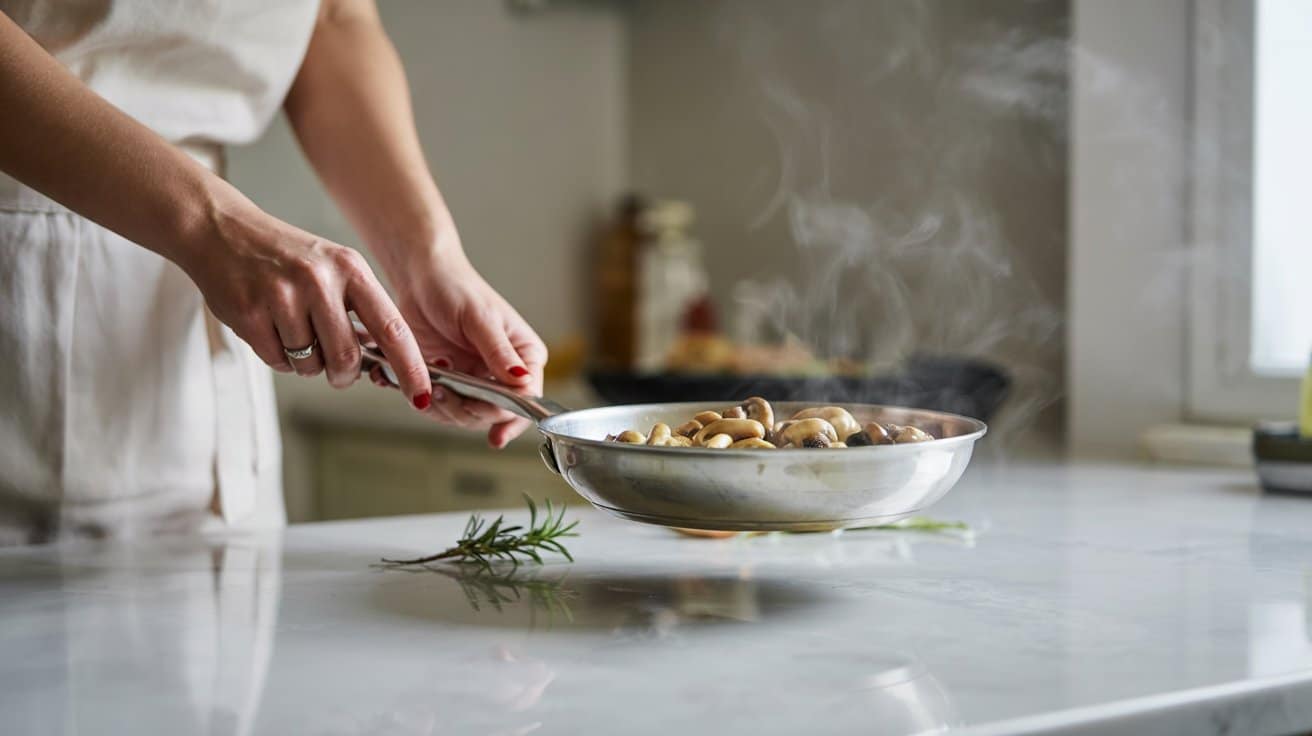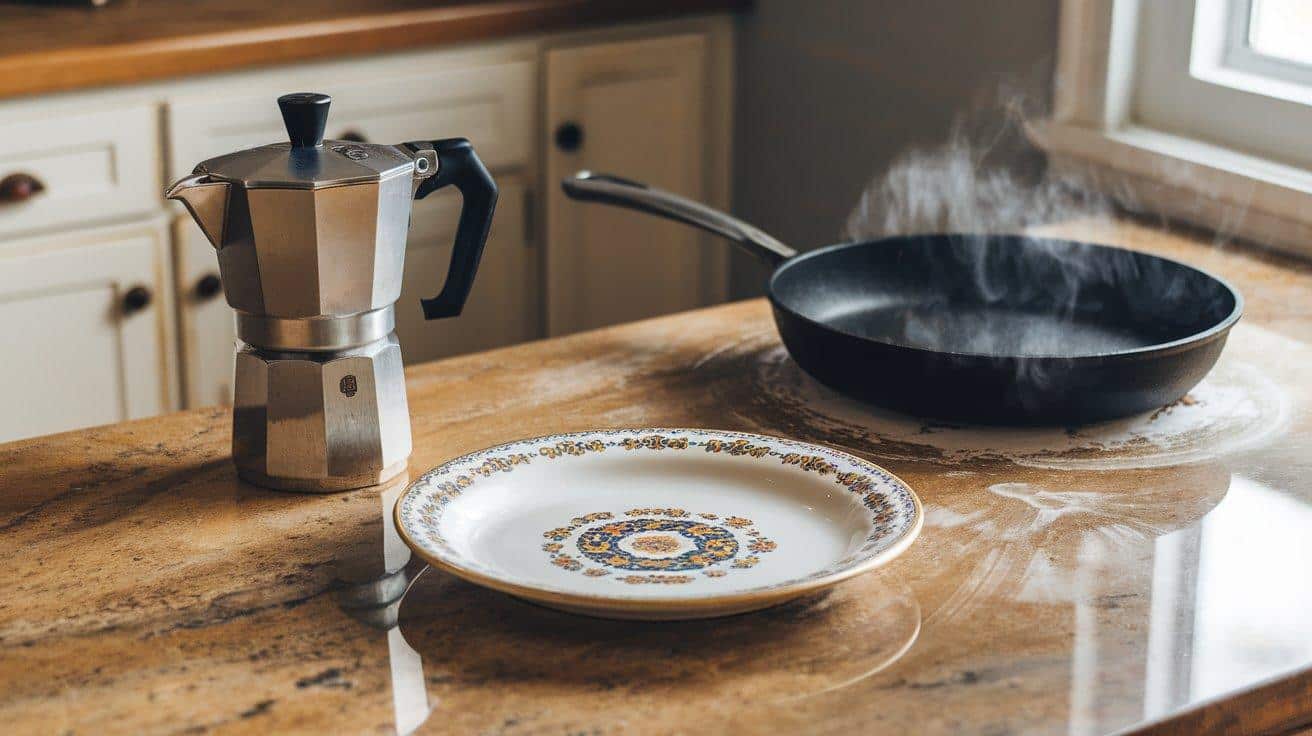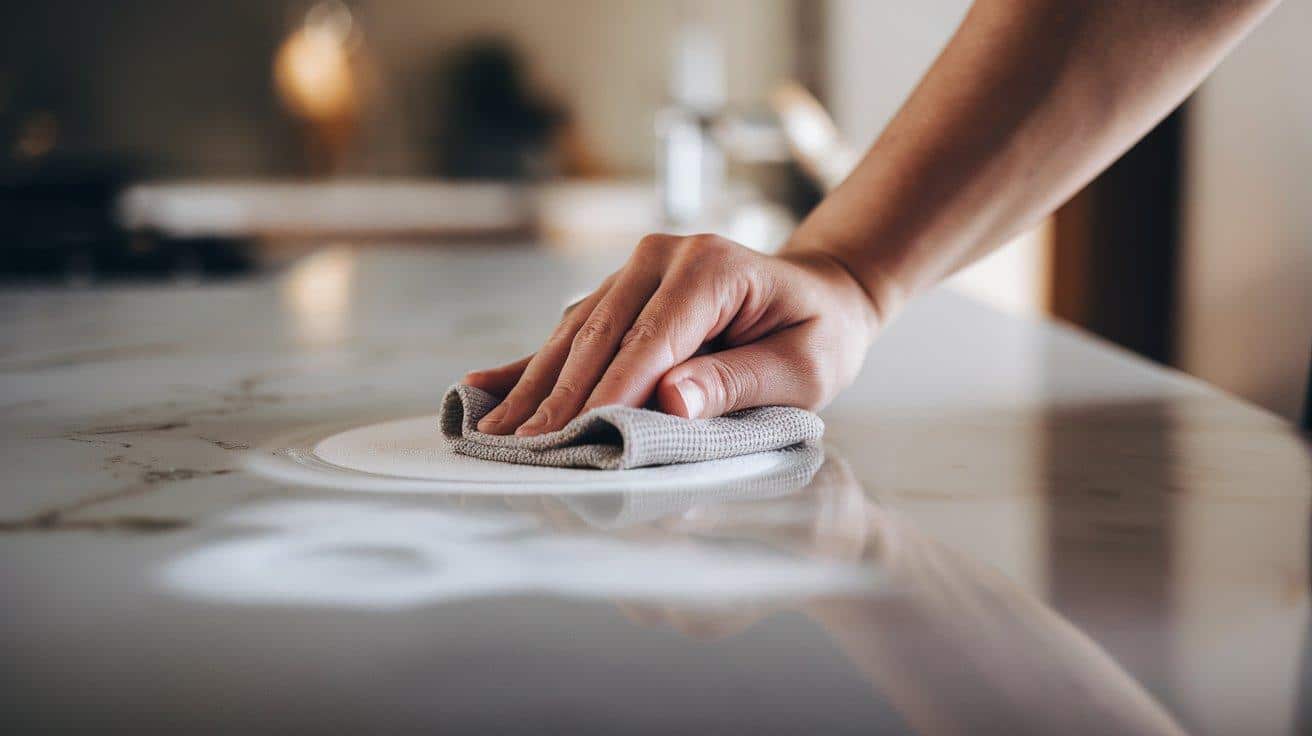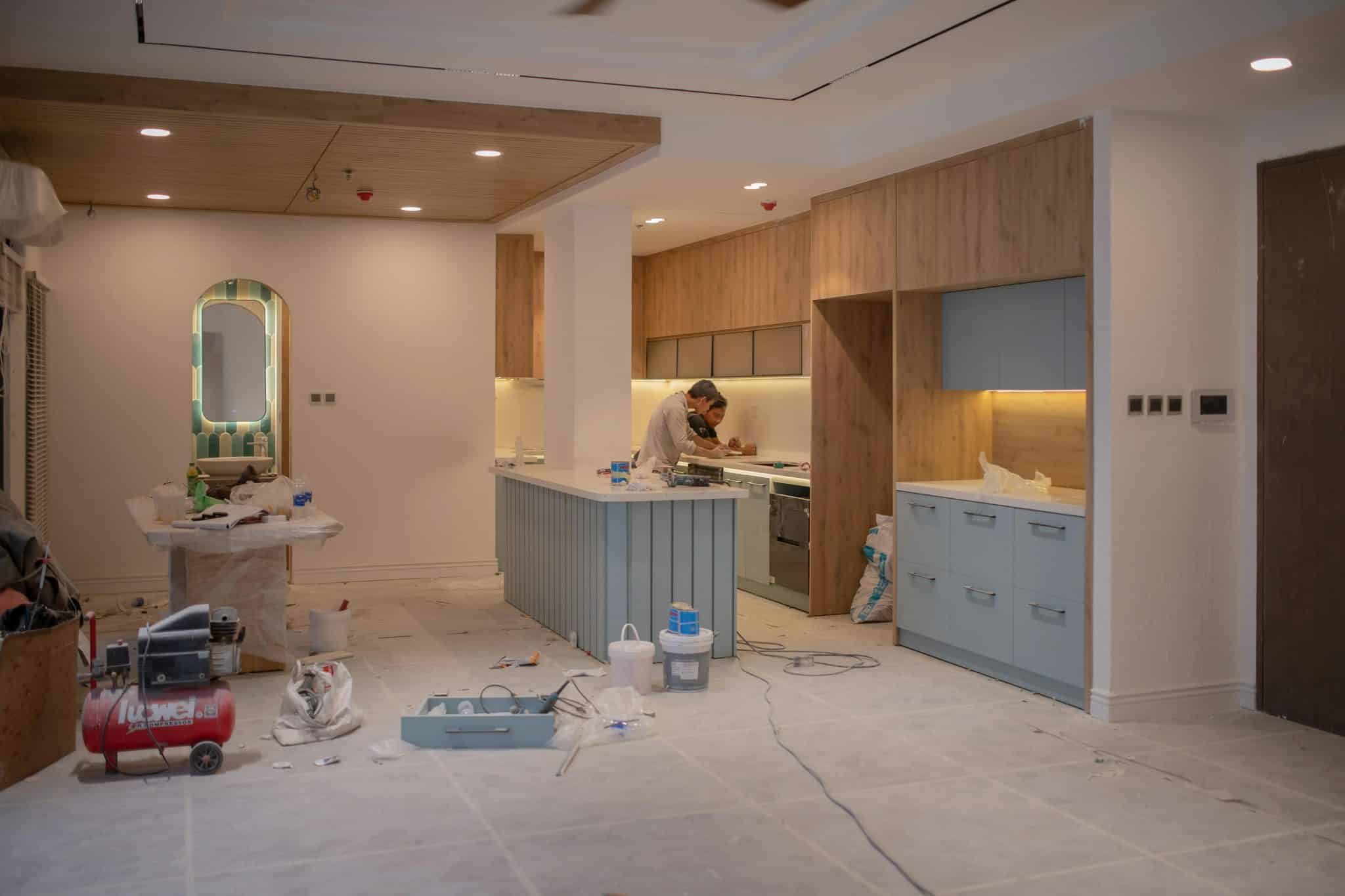Can your kitchen countertop handle that hot pot straight from the stove?
This question matters more than you think when choosing quartz countertops for your home.
Quartz surfaces look beautiful and work well in busy kitchens. But heat can cause serious problems that cost hundreds or thousands to fix later. The damage often happens without warning.
Many homeowners pick quartz without knowing how heat affects it. They place hot pans directly on the surface, thinking it’s safe. They learn the hard way when white marks and cracks appear overnight.
I’ll show you exactly how much heat quartz can take and what factors affect heat resistance in quartz countertops. You’ll also learn smart ways to protect your investment and keep your counters looking perfect for years to come.
What Are Quartz Countertops Made Of?
Quartz countertops contain mostly natural quartz crystals mixed with other materials. This mix creates a hard surface that works well in kitchens and bathrooms. The manufacturing process combines these materials under high pressure and heat.
Most quartz countertops use about 90-95% ground quartz crystals. The remaining 5-10% includes polymer resins, pigments, and other binding agents that hold everything together.
Main Components:
- Natural quartz crystals (90-95%): Provide hardness and durability
- Polymer resins (5-7%): Acts as a binding agent
- Pigments (1-3%): Adds color and patterns
- Other additives: Glass, metallic flecks, or recycled materials
Heat Resistance that Quartz Countertops Have
Quartz countertops handle normal kitchen heat but aren’t fully heatproof. Knowing their limits saves you from costly repairs.
Basic Heat Tolerance: Quartz works well for everyday cooking tasks. Warm pots and heated dishes won’t hurt it. The quartz crystals inside can take high heat, but the binding resins cannot.
Your countertop handles regular kitchen use just fine. When cookware gets too hot, though, the resins break down and cause white marks or cracks.
Temperature Limits of Quartz
Safe Range: Up to 150°C (300°F) for brief contact. Coffee pots, warm plates, and cooling dishes stay in this safe zone.
Danger Zone: Above 150°C (302°F), the resins are damaged. Hot pans from the stove, hair tools, and some appliances cross this line.
When resins break down, you get white marks and surface cracks that won’t go away.
Key Point: Use trivets or hot pads for anything straight from the stove or oven. This simple step protects your investment.
Heat Resistance: Quartz vs. Other Countertops
Different countertop materials handle heat in very different ways. Here’s how quartz compares to other popular options:
| Material | Heat Resistance | Max Temperature | Heat Damage Risk | Overall Rating |
|---|---|---|---|---|
| Quartz | Moderate | 150–200°F safer, up to 300–400°F possible but risky | Medium | ★★★ |
| Granite | High | 1,000–1,200°F (stone), 450–500°F (sealant) | Low | ★★★★★ |
| Marble | Moderate | Up to 480°F | Medium-High | ★★ |
| Laminate | Very Low | 230–250°F | Very High | ★ |
| Concrete | High | 800°F+ | Low | ★★★★ |
| Butcher Block | Low | 250–300°F | High | ★★ |
Granite clearly wins for heat resistance, while quartz offers good performance for normal kitchen use.
Factors Affecting Heat Resistance in Quartz Countertops
Several factors determine how well your quartz countertop handles heat. Understanding these helps you make better choices.
1. Resin Content and Quality
Higher resin content means lower heat tolerance. Premium brands often use better resins that handle heat slightly better than cheaper options.
Different resin types also affect performance. Some manufacturers use heat-resistant polymers that can handle temperatures up to 400°F instead of the standard 300°F.
2. Thickness of The Slab
Thicker quartz slabs distribute heat better than thin ones. Standard 3cm (1.25 inch) slabs handle heat better than 2cm (0.75 inch) versions.
Extra thickness helps disperse heat evenly, reducing the risk of concentrated damage. This reduces the risk of concentrated damage.
3. Color and Pattern
Dark colors: They absorb more heat and show damage more easily than light colors. Black and dark gray quartz need extra care around hot items.
Light colors: This includes white and cream, which hide minor heat marks better. They also reflect heat instead of absorbing it.
Patterns with veining: It can hide small heat marks better than solid colors. The natural variation helps mask minor damage.
4. Manufacturing Process
Better manufacturing creates stronger bonds between quartz and resin. This improved structure handles heat stress better than cheaper alternatives.
Premium brands use advanced pressing techniques and longer curing times. These processes create countertops that resist heat damage better.
Tips to Protect Quartz Countertops from Heat Damage
Simple steps prevent heat damage and save you money on repairs. Follow these basic rules to keep your quartz counters safe:
- Place trivets or hot pads under any hot pot, pan, or dish before setting it on your counter.
- Wait 2-3 minutes after removing pans from the heat before placing them down.
- Keep heat mats under coffee makers, toasters, and other hot kitchen appliances.
- Use cutting boards with feet to create air space that protects the surface.
- Never place curling irons, straighteners, or other heated beauty tools on quartz.
- Use oven mittens when moving hot items to remind yourself they need protection.
- Install heat-resistant landing strips near your stove for temporary pot placement.
Repairing Heat Damageon Quartz Countertops
Heat damage doesn’t always mean buying new countertops. Your repair options depend on how bad the damage looks.
In case of minor heat marks: Light white spots or dull areas can often be fixed with gentle polishing. Use quartz polishing compounds and work in small circles.
Test any product in a hidden spot first. Some cleaners make damage worse or create new stains.
Seek professional repair when: Bigger white marks or shallow cracks need expert help. Certified repair specialists have special tools homeowners can’t buy.
Mobile repair teams can fix problems at your home without removing the countertop. This costs less than replacement and takes just a few hours.
Full replacement is needed: when Deep cracks that go all the way through can’t be safely repaired. Large damaged areas also need complete replacement.
Structural damage that makes the countertop unstable requires immediate replacement for safety. Don’t wait when cracks spread or sections come loose.
Heat Damage on Quartz Countertops Repair Costs
- DIY polishing: $15-30 for minor marks
- Professional repair: $200-500, depending on the size of the damage
- Partial replacement: $500-1,500
- Full replacement: $2,000-5,000+
- Prevention with trivets: Under $20
Note: Prevention costs much less than any repair option.
Final Thoughts
Quartz countertops offer lasting value if you care for them the right way. They handle daily kitchen tasks with ease but require smart heat protection.
High temperatures can cause permanent damage to quartz surfaces. That’s why using trivets and heat pads becomes essential for long-term durability.
These simple tools prevent costly repairs and keep your counters looking new. You don’t need to sacrifice style for protection. Today’s trivets and heat-resistant mats come in sleek designs that complement any kitchen decor.
They blend function with form perfectly. A few inexpensive accessories can prevent costly repairs and extend your countertop’s life.
What’s your experience with quartz counters? Have you found effective ways to protect them from heat? Share your tips and questions in the comments below.
Frequently Asked Questions
What Ruins Quartz Countertops?
Avoid these items that damage quartz surfaces: sealants (quartz doesn’t need sealing), rough sponges that dull the finish, bleach, ammonia, sharp knives, very hot pans, and strong alkaline cleaners.
Can You Put a Microwave on A Quartz Countertop?
Yes, microwaves are safe on quartz countertops. Quartz won’t absorb heat or moisture from appliances, making it perfect for kitchen equipment placement without risk of damage.
What Are the Three Grades of Quartz?
Quartz comes in three quality levels: first choice (premium), commercial-grade (mid-range), and second choice (budget). Each grade affects price, strength, appearance, and home value differently.










